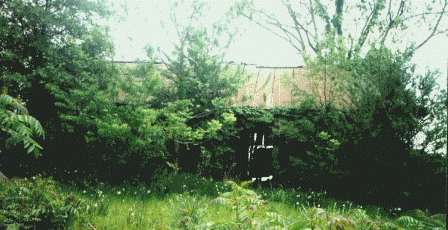

Old house with dogtrot at Vinity
Vinity Community, now identified on the White County map as Vinity Corner, dates back to pre-Civil War time. The community name has changed during the years. It has carried the title of Hales Store, Sayes Chapel and Cheeks Plantation through the years. Ranes, 1899 to 1907, and DesCane, 1913 to 1918, were post offices there. For a time there was no local post office and Defiance received and posted the mail. For many years now a rural mail route has served; for a number of yers out of Garner, and more recently out of Searcy.
Cheek, Durham, Saye and Hale were prominent family names in the community during the mid-19th century. The late Dr. John R. Sloan listed Jeff Saye, Tom Ferguson, Sam Claiborne, Shade Baker, Bill Dailey, "Grandma" Jackson, Jack Wilkes, (Mr.) Hazel Watson, Tom Morris, "Widow" Lawrence, Hewey Ragsdale and Fate Price as heads of households in the Vinity-Lebanon area before 1900. Jim Bone, Jim and John Smith were heads of households with large families living in Vinity before 1900.
Tax assessment records (White County 1858), A.L. Cheek, number of slaves over 5 years and under 60 years of age 3. The Cheek lands (about one section of land) lay mostly on the ridge east of Cheek Lake.
Again, to quote John John McCarver, now (1975) of Malvern, Arkansas, formerly of Dahlgren, Illinois, who reconstructs a conversation in Dahlgren some years ago (1911): The Reverend Austin Glenn, after having learned that L.M. Cross had purchased land near Cheek Lake in Arkansas, remarked, "During the winter of 63, I wintered with my outfit on the Cheek Plantation and became well acquainted with Mr. Cheek and his family. He was a fine man."
From the very earliest settlement in Vinity until the early 1900s the community was in the Des Arc trade area. The road to Prairie County generally southeast into Prairie County, thence only about 10 miles into Des Arc. Cypress Bayou forms the White-Prairie County line. Fullers Ford was the most often used route from Vinity to Des Arc.
Willard Case, Kloss and Essex timber companies served the area at different times, by providing jobs and a timber market until past the halfway mark of this century.
Sayes Chapel, organized as a part of the North Arkansas Methodist Conference before 1880, functioned always as a unit of a circuit or as an extension in that conference until after 1950. An active Church of Christ (building still standing) functioned from 1948 to 1973.
Vinity school was organized as a school district before 1900 and continued to serve the community for some years after the consolidation with Garner (1939). The area is now a part of the Beebe School District.
Jefferson Saye (second generation from England) was of the same family as Lord Saye.